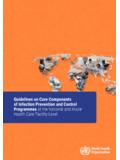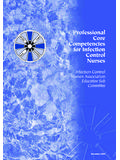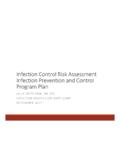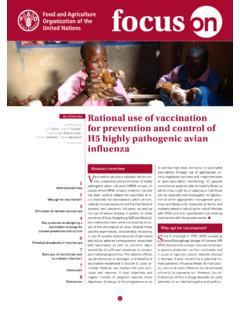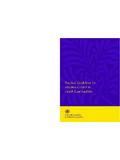Transcription of PRACTICAL GUIDELINES FOR INFECTION CONTROL IN …
1 I PRACTICAL GUIDELINES FOR INFECTION CONTROL IN HEALTH CARE FACILITIES World Health Organization 8 December 2003 iCONTENTS 1. INFECTION CONTROL practices ..1 Purpose ..1 Objectives ..1 Use of the GUIDELINES ..2 2. INFECTION CONTROL programme ..3 Need for an INFECTION CONTROL programme ..3 What is an INFECTION CONTROL programme? ..3 Organization of an INFECTION CONTROL programme ..4 INFECTION CONTROL INFECTION CONTROL INFECTION CONTROL Education and training of health care staff ..6 3. INFECTION CONTROL practices ..7 Standard Hand washing and Antisepsis (hand hygiene)..7 Use of personal protective equipment ..8 Principles for use of personal protective Prevention of needle stick/sharps injuries.
2 11 Management of health-care waste ..11 Additional (transmission-based) precautions ..11 Airborne precautions ..11 Droplet Contact precautions ..12 Patient placement and transportation of patients ..13 Patient Spacing between Single rooms ..13 CONTENTS ii Cohorting .. 13 Transportation of patients .. 13 4. Environmental management rractices .. 14 Premises/buildings .. 14 Air .. 14 14 Special air handling for airborne precautions .. 15 Protective environment .. 15 Water .. 16 Safe drinking water .. 16 Cleaning of the hospital environment .. 16 Waste management .. 16 Principles of waste management .. 17 Treatment of hazardous and clinical /infectious waste.
3 17 Methods of disposal .. 17 Laundry .. 20 General instructions .. 20 Bedding .. 20 Reprocessing of instruments and 20 Cleaning, disinfection and 23 Cleaning .. 23 Disinfection .. 24 Selection of disinfectant .. 25 Sterilization .. 26 Special consideration - CJD .. 28 Used personal protective equipment .. 30 Soiled linen .. 31 Soiled patient care equipment (needles, syringes, surgical instruments and other equipment) used for 31 Equipment in the isolation unit (tables, beds, lockers, trolleys, etc).. 32 Environmental surfaces in the patient's room .. 32 5. Care of health care 33 Exposure to human immunodeficiency virus (HIV) .. 33 Exposure to hepatitis B virus.
4 33 Exposure to hepatitis C virus .. 34 CONTENTS Sharps injuries ..34 Meningococcal SARS ..35 Other infections ; varicella, influenza, pertussis, diphtheria, rabies ..35 6. INFECTION CONTROL precautions for selected situations ..36 Severe acute respiratory syndrome (SARS) ..36 Causative agent ..36 Mode of transmission ..36 Susceptibility ..36 Clinical picture in SARS patients ..36 Clinical case definition of Laboratory case definition of PCR positive for Seroconversion by ELISA or IFA ..37 Virus INFECTION CONTROL precautions for SARS ..38 Transportation of patients with SARS ..38 Personal protective equipment used for Who should use personal protective equipment?
5 39 Waste disposal ..39 Specimen collection and Hospital screening, admission procedures and Care of SARS patients in isolation ..40 Preparation of the isolation room ..40 Entering the room ..41 Attending the Excreta ..41 Leaving the room ..42 Discharging the patient ..42 Care of the CONTENTS iv Post mortem .. 43 Minimizing the risk from an infected cadaver .. 43 Use of a circulator (assistant) 43 Mortuary care/ funeral director's 43 infections with multidrug resistant organisms .. 44 Appropriate antimicrobial 44 Antimicrobial use committee .. 44 CONTROL of endemic antibiotic 45 Methicillin-resistant Staphylococcus aureus (MRSA).. 45 Vancomycin-resistant enterococcus (VRE).
6 45 Transmission .. 46 46 INFECTION CONTROL measures for VRE .. 46 Contact precautions .. 46 Multidrug-resistant tuberculosis (MDR-TB) .. 46 46 Occurrence .. 47 Transmission .. 47 INFECTION CONTROL measures for MDR-TB .. 47 Standard and airborne precautions.. 47 Health care 47 infections with viral Haemorrhagic 47 References .. 49 Glossary .. 51 Annex 1 - Hand 53 Annex 2 - Personal protective equipment .. 58 Annex 3 - INFECTION CONTROL : a quick reference guide for .. 67 Annex 4. - Suggested checklist for SARS trolley/table .. 68 Annex 5. - Isolation room .. 69 Annex 6 - INFECTION CONTROL advice to contacts of suspect or probable SARS cases .. 70 Annex 7 - INFECTION CONTROL 72 Acknowledgements.
7 74 vFOREWORD The World Health Organization (WHO) has recognized severe acute respiratory syndrome (SARS) as the first severe and readily transmissible new disease to emerge in the 21st century. Despite rapid progress towards understanding the disease and the transmission of the SARS Co-V, there are still many gaps in our understanding of SARS. It was very clear during the SARS outbreak however, that this virus was easily spread through international air travel and close hospital contact. In fact health care facilities amplified the disease in all severely affected countries. The experience in affected areas showed very clearly that the transmission of the SARS Co-V can generally be prevented.
8 Because there is no known effective treatment and no available vaccine, health authorities had to resort to basic public health measures. Rapid case detection, immediate isolation, contact tracing and good INFECTION CONTROL precautions are critical in the prevention of INFECTION . However, as SARS spread, it became obvious that many countries lacked the necessary infrastructure, facilities, equipment and trained personnel to provide appropriate precautions. Health care facilities in both developed and developing countries were far from prepared to deal with such a disease. It is essential that all countries strengthen their regional and national surveillance and response systems and their INFECTION CONTROL capacities, in particular hospital-based INFECTION CONTROL departments.
9 In order to support countries to deal with SARS and to prevent further spread of INFECTION , the WHO Regional Offices for South-East Asia and the Western Pacific have jointly prepared these GUIDELINES . The GUIDELINES address all aspects of an INFECTION CONTROL programme and devote considerable attention to SARS. Since information on SARS is still evolving, these are interim GUIDELINES . They may need to be updated as and when more specific information becomes available. WHO would greatly appreciate feedback from those who use these GUIDELINES . We hope that these GUIDELINES will be found useful by health professionals at all levels who have to deal with SARS and other health-care-associated infections .
10 Dr Uton Muchtar Rafei Dr Shigeru Omi Regional Director Regional Director WHO Regional Office for South-East Asia WHO Regional Office for Western Pacific 1 1. INTRODUCTION BACKGROUND The emergence of life-threatening infections such as severe acute respiratory syndrome (SARS) and re-emerging infectious diseases like plague and tuberculosis have highlighted the need for efficient INFECTION CONTROL programmes in all health care settings and capacity building for health care workers so they can implement them. An INFECTION CONTROL programme puts together various practices which when used appropriately restrict the spread of INFECTION . A breach in INFECTION CONTROL practices facilitates transmission of INFECTION from patients to health care workers, other patients and attendants.


